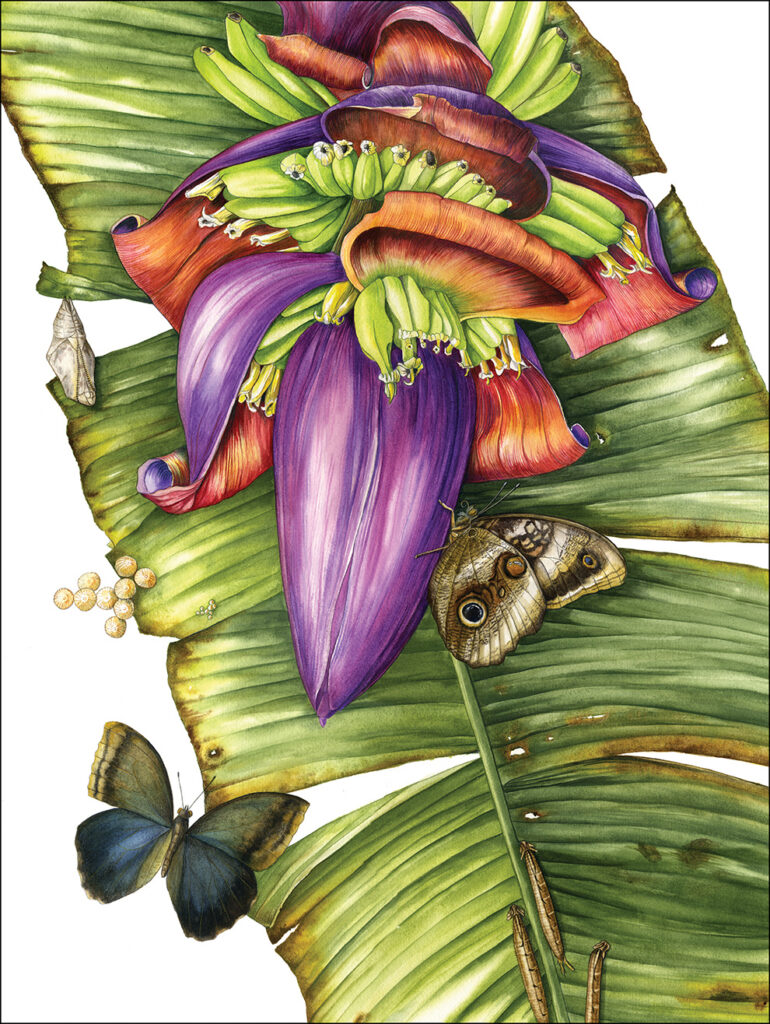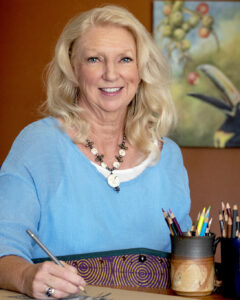
Mindy Lighthipe works from both sides of her brain and her heart as a natural science and nature artist/illustrator and educator.
In the early 1990s, artist and educator Mindy Lighthipe had just turned 30 and had never ventured outside the United States. She watched as Desert Storm dominated the 24-hour news cycle between interviews with pop star Sting and other celebs championing the “Save the Rainforest” movement. But watching dewy tree canopies and exotic creatures on TV wasn’t enough for her. That was when she realized what she really wanted was to be in a rainforest.
She also recalls being influenced by an art exhibit around the same time. The artist had created an intricate graphite drawing of a rainforest, including many species of plants and animals, on the gallery’s walls.
“It must have taken her months to create. It was breathtaking. As part of the exhibit, she had erasers and instructed the gallery goers to go to her work and erase part of the drawing. It was shocking to think anyone would erase such a beautiful creation. This was exactly her point. People were very reluctant. There were parts which were erased, leaving only a trace of what had been there,” Lighthipe recalls. “We, as humans, were erasing the natural beauty of the rainforest by our actions—exploiting it through habitat loss, poaching and destruction. I was deeply moved and knew I needed to experience the beauty of the rainforest in hopes to somehow be a part of helping to save it.”

Born in New Jersey, Lighthipe had focused her studio arts Bachelor of fine arts degree and art education master’s degree studies on fiber arts and printmaking up until that point, and says she had never witnessed such amazing biodiversity up close.
“I was at that place in my career where I had immersed myself in textiles, and then I just found that I was just not super happy,” she recalls. “I’d made a living at it, but I just felt like I really wanted to do more nature-oriented art and started getting into drawing animals and insects.”
In Costa Rica, Lighthipe began painting with watercolors, excited and inspired by the toucans, sloths and mind-boggling variety of birds and bugs she was encountering.
“I absolutely fell in love with Costa Rica,” she professes, “and I’ve been making the trek back every single year.”
Lighthipe’s passion for plants and wildlife led to a teaching job in an illustration program at the New York Botanical Garden, a position she held for 15 years. While teaching there, her students asked about her trips to Central America.
“When are you going to take us?” the students prodded.
“I was like, ‘Oh, you wanna go? Okay!’ and it’s been 25 years that I’ve been doing it,” she shares.

Lighthipe currently coordinates annual educational trips to Selva Verde Lodge in Costa Rica with Holbrook Travel in Gainesville, and despite the hassles of TSA checks, travel expenses and corralling students ranging in age from 35 to 80, the annual sojourns never get old for her. Every year, she’s just as excited as the last to go back.
DRAWING CONCLUSIONS
Unicorns and horses filled Lighthipe’s notebooks as a child, but her artistic range and her menagerie of illustrated creatures grew exponentially after she popped open her first box of Crayolas.

Lighthipe didn’t know, however, that becoming a professional illustrator meant going back to the drawing board, literally.
“I decided to go back to school and get another degree and that’s when I got a certification in botanical illustration,” Lighthipe explains. “When I entered that program, I went to an open house and they wanted you to bring a portfolio of your work for them to review.”
The woman who reviewed her work was the program’s coordinator at the time.
“She looked at me, and she said, ‘You need to take Drawing 1,’ and I looked at her like, ‘Are you crazy?’ I thought my education in college was fantastic. It was fantastic from the craft angle of it, like pottery and jewelry making or furniture making, but she told me I needed to learn technique.”
Lighthipe had no idea that the outcome of everything she would ever do from that point forward resulted from a solid foundation in drawing.
 “I would not be successful,” she offers. “Even though I could pick stuff up and draw, did I understand proportion? Did I understand scale? Did I understand all of the things that you would need to do to do the type of work? Like if you wanted to be an abstract artist, that would be something different. But to do the type of work that I wanted to do, I needed to absolutely, positively know the ins and outs of drawing. And so, when the woman told me that I had to take Drawing 1, I begrudgingly took it, and if you talk about a pivotal moment in my life, when I came out of the second class of Drawing 1, I was completely humbled. I was like, ‘I don’t know how to draw. This woman was totally right.’ I thought that drawing was more of a talent than it is actually a skill.”
“I would not be successful,” she offers. “Even though I could pick stuff up and draw, did I understand proportion? Did I understand scale? Did I understand all of the things that you would need to do to do the type of work? Like if you wanted to be an abstract artist, that would be something different. But to do the type of work that I wanted to do, I needed to absolutely, positively know the ins and outs of drawing. And so, when the woman told me that I had to take Drawing 1, I begrudgingly took it, and if you talk about a pivotal moment in my life, when I came out of the second class of Drawing 1, I was completely humbled. I was like, ‘I don’t know how to draw. This woman was totally right.’ I thought that drawing was more of a talent than it is actually a skill.”
 NOT A TEXTBOOK CASE
NOT A TEXTBOOK CASE
A solo exhibition at the Florida Museum of Natural History in Gainesville brought Lighthipe to Florida 15 years ago. She currently lives in The Villages with her husband, Joseph Annichiarico.
They kayak together when Lighthipe isn’t volunteering for Sweet Water Rescue and Rehab, an animal sanctuary in Williston.
“I kayak with my camera, which is a little crazy,” she says with a laugh. “I love to photograph birds while kayaking and on the Lake Apopka Wildlife Drive.”
Author of The Art of Botanical & Bird Illustration with Walter Foster, Lighthipe has written and illustrated children’s books such as Mother Monarch. She co-authored Where the Wild Sloths Roam with Denise Gillen and created a deck of Tarot-like cards called Nature’s Wisdom Oracle. She recently added greeting cards to the mix.
Her illustrations have been featured in wildlife, animal art and nature magazines and books. As an adjunct professor at the University of Florida, she has taught anatomical illustration in the ornithology, mammalogy and entomology departments.

Accomplishments aside, Lighthipe strives to remain grounded.
“I’m definitely not a purist,” she shares. “I’ve done a lot of technical pen and ink that goes into textbooks. I don’t like it as much as the other stuff that I do, which I think is more expressive. People sometimes think if you’re a scientific illustrator, that there’s no room for anything except clinical perfect drawing.”
Lighthipe started out working in graphite. She says it allows her to work out the surface contours, textures and pigmentations and also the anatomical component of her subjects.
On her YouTube channel, she explains she uses watercolor as an expressive and spontaneous method for fur, feathers, flowers and various textures. Colored pencils allow her to create vibrant shimmering colors while working in layers.
“Gouache is also an amazing medium,” she offers. “It’s similar to watercolor but has an opacity to it—wonderful to work with, particularly when I’m re-creating fur.”
“Sometimes, I work with colored pencils and pastels for the backgrounds,” she notes.
She also uses solar printing, a printmaking method that does not use harsh chemicals.
“I create my plate that I print in black and white, then I go in and hand-tint the colors. Each one is individual and unique. I can create an edition of approximately 25 to 50 images with one of my solar etching plates through a vast knowledge of different approaches and techniques. I’m able to grow and apply combinations to create my unique vision of the natural world.” OS
For more information, visit mindylighthipe.com.








